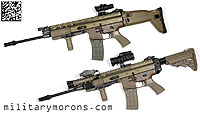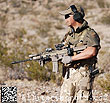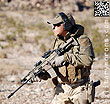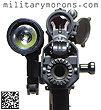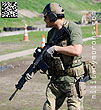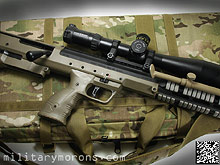Long Guns (non-AR) Page 1 Page 2 Page 3 Page 4
TO VIEW FULL SIZE IMAGES: USERNAME and PASSWORD are both "mm"
Vltor AR Stock Adapter for the FN SCAR 16/17S (Preview)
10/1/10 - The FN SCAR 16/17S stock adapter and extension from Vltor Weapons Systems is a direct drop-in replacement for the standard SCAR stock. It enables any standard AR-15 stock to be mounted on the SCAR, offering the end user more options than just the factory SCAR stock. Ever since the FN SCAR came out (and even before), end-user comments on its distinctive-looking stock has been all over the board. Some people love it, some hate it, and some are ambivalent. The aesthetics took a while to get used to (or not), and the SCAR stock has been compared to a boot, fish tails, amongst other things. Functionally, the SCAR stock is pretty versatile. It folds to the right, reducing the overall length of the weapon for compactness in vehicles, storage, transportation etc. There's an adjustable comb/cheekpiece with two height settings, to accomodate various optics. The stock is also retractable with six length of pull settings, and has a tall concave rubber buttpad that is both comfortable and stable. So, why swap it out with an AR-style stock? The folding mechanism latch/button of the SCAR is made of plastic and has been known to break. While comfortable on the shoulder, I've found the curved foot of the stock not as comfortable with armour, where I prefer an angled toe. The SCAR stock has no storage compartments and as mentioned before, not everyone like its aesthetics (I don't mind it at all). Some may not like the aesthetic of an AR stock on the SCAR either, but it's functional and offers the user different options. As far as I'm concerned, the more options that are available to the consumer, the better. Note that the unit shown here is a pre-production version - there will be some changes in the production version. Mainly, the adapter block will be much lighter than the one pictured here. Description - The Vltor SCAR stock adapter consists of an adapter block and proprietary Vltor 6-position extension tube. Adapter block - The adapter block is machined out of aluminum and has QD sling swivel cups on both sides (they're not rotation-limiting; I'd like them to be). It has a female dovetail clamp, that the extension tube rides in. The adapter block slides onto the receiver in the same way the factory stock plate does. Extension tube - The extension tube is the same one as used for the Vltor M-14 stock, has a government diameter, and is compatible with all AR stocks that use a standard tube. It doubles as a storage space, with an O-ring sealed knurled cap on the rear. It has six positions, which are marked on the top of the tube. The front end of the tube has a male dovetail that slides in from the top into the adapter block. Locking and adjustment - On the right side of the adapter is the locking lever. It has a crossbolt, and when tightened, it secures the tube in the adapter by clamping the sides of female dovetail together. When loose, the tube is free to slide up and down in the adapter, only limited by the travel of the locking lever cross bolt in its slot. This provides the height adjustment for the stock. The locking lever cams into the closed position, which clamps the tube at the desired position in the adapter (works in a similar fashion to the ADM DQ mounts). There is an octogonal nut on the opposite side which can be rotated to adjust the amount of clamping force exerted when the lever is locked. The lever itself has a sliding lock (the little buttons on both sides), which needs to be pulled outwards to release the lever from the locked position. This prevents it from accidentally opening or loosening. To provide enough leverage to open the lever, the base of a 5.56mm case is slid into grooves in the lever and used as a handle. The lever has two open positions - midway and fully open. The midway position loosens the clamp enough to adjust the height of the extension tube. The fully open position allows the octogonal nut on the other side to be rotated to adjust the clamp tension. The lever can be installed pointing up or down.
Installation - Installing the Vltor SCAR stock adapter is as simple as removing the factory stock and sliding the Vltor adapter on. It takes less than half a minute for the entire operation, taking my time. With an IMOD stock shown below for comparison, the IMOD offers more adjustment in height as well as length. The IMOD is shorter than the factory SCAR stock in the fully closed position, and longer fully extended, so it'll accommodate a wider range of folks. The height is infinitely adjustable within the range of travel, as opposed to the two positions of the factory cheek piece. Notes/Observations - The Vltor setup adds some weight to the rifle, as it's made of aluminum vs. plastic, and you also lose the ability to fold the stock. I seldom use that feature except for transportation, but other users might have other needs in mind. The Vltor stock is definitely more solid feeling that the factory one, but the main advantage (to me) are the options that are available with different AR stocks, and the added adjustability. Just for illustration, the SCAR is shown below with the Vltor IMOD, Magpul CTR and Crane stocks. I find the factory SCAR stock very comfortable to shoot against the bare shoulder, but the angled buttplates of the IMOD and CTR stocks are more compatible with body armour/plates than the factory SCAR stock with its concave buttplate. Combined with the storage in the tube extension, a stock like the Vltor IMOD will provide storage space for spare parts and batteries. While some purists dislike the idea of putting an M4 stock on non-AR weapons, the basic M4 stock design and all the different options available are hard to beat - that's why it's done so often. It's up to the end user to decide which configuration works best for his personal needs and preferences, and it's to the consumer's advantage to have more options available. |
TangoDown Hyperion SCAR Stock Latch and Charging Handle
10/3/11 - The first two items from TangoDown's Hyperion line of upgrades for the FN SCAR weapon platform are now available - the Aluminum Stock Latch and the Angled Charging Handle. The TangoDown Hyperion range is designed to enhance ergonomics, durability and component cmopatibility of the FN SCAR Heavy and Light rifles, both military and commercial versions. Some changes have been made since the line was first announced at the 2011 SHOT show. Aluminum Stock Latch - FN is one of the oldest and innovative weapon manufacturers in the world, and the SCAR is the latest example of their expertise in metal replacement on firearms. The SCAR system utilizes a large portion of polymer successfully in its execution, especially in the butt stock. However, the weak link is the plastic stock latch that holds the stock in the open position. In combat operations, the plastic latch can fail (they've actually been known to be broken right out of the box) from a slight sideways impact, rendering the stock is suddenly unusable. TangoDown's FNS-ASL replaces the breakage-prone plastic part with a quality machined, aircraft grade 7075 aluminum replacement. The FNS-ASL is rugged & durable, and TYPE III hard coat anodized for superior corrosion resistance. The latch face is machined with a dished, non-slip, checkered surface. At the initial announcement, the dished surface was smooth, with no texture. The FNS-ASL fits the MK16, MK17 and MK20 SSR, and all commercial models MK16S AND MK17S. The ASL is a direct replacement for the OEM stock latch, and is a drop-in part. It literally takes 15 seconds to swap them out. Angled Charging Handle - While the SCAR's monolithic upper receiver with full-length top rail provides the user with a lot of real estate to accommodate any choice of current optics and sights, the OEM charging handle can often become a knuckle or finger buster. The short length and straight shape seldom offers proper hand clearance when mounting QD throw lever optic mounts or reflex sights. TD's FNS-ACH charging handle eliminates this operational hazard, allowing proper charging of the weapon without damage to hands or fingers. The unique design is angled to allow up or down orientation, on either the left or right side of the weapon. Its shape is easy to grasp with or without gloves, and the rounded contours will not become sharp if impacted during field operations. Serrations are machined into the front and rear for a secure grip. When initally announced, the ACH was designed as high impact polymer over a steel stem. The production version is one piece for optimum strength, and is quality machined from a block of 4340 steel, heat treated to 40 Rockwell, then manganese phosphate coated to MIL-STD 171. This was done to eliminate the chance of the polymer breaking off from an impact, and leaving sharp edges. The FNS-ACH fits the MK16, MK17 and MK20 SSR, and all commercial models; the MK16S and MK17S. Like the ASL, the ACH is a drop-in replacement part for the OEM charging handle, literally taking seconds to install. I'm a lefty, and installed it on the right side. After trying it out angled up and down, I found that I prefer it angled up, as my optic is mounted far back enough so I don't need the clearance.
6/8/12 - FN SCAR Extended Side Rails - The next item from TangoDown's Hyperion SCAR Performance Line is the FN SCAR Extended Side Rails (ESR). These extended rails are a direct replacement for the factory side rails, and have the added functionality of rotation-limited QD sling swivel cups at both ends. When the SCAR 16S and 17S came out, I was surprised to see that the side rails were made of plastic. While I don't subject my 16S to the abuse that others may, I'm not sure that plastic side rails were the best choice, for the miniscule weight savings over aluminum ones. That, combined with the lack of forward sling attach points, other than the loop near the front sight left a couple of things to be desired. TangoDown's solution addresses both concerns/issues with their ESR. The ESR as machined from 7075 aircraft grade aluminum and type III hard anodized black. In addition, the ESR is extended past the length of the factory rail to accommodate rotation-limited QD sling swivel cups at both ends of the rail. The user now has the choice of attaching his sling to the rear of the rail (my preferred attach point), or the front, using a standard QD sling swivel. Note that since the ESR extends past the front of the receiver, it is not compatible with rail extensions like the PWS SRX (unless you cut off the front end of the rail). The FNS-ESR fits the MK16 and MK17 and all commercial models; the MK16S and MK17S. The ESR is a drop-in replacement for the factory side rails, and the first step is to remove the barrel. Next, the factory side rails are removed by unscrewing them from the side rail block in the front, and the square side rail nut in the rear (see photo below). The barrel extension screw and screw spring are then transferred from the factory rail to the ESR. The ESR is then screwed onto the receiver with the factory rail screws, and the barrel re-installed and torqued.
|
Vltor CASV-FA Handguard for the FAL
1/14/10 - Vltor Weapons Systems is introducing a CASV handguard for FN FAL metric variants, called the CASV-FA. The CASV-FA is a light weight, drop-in handguard that requires no modification to the weapon, and allows users to install rails where they choose. At the time of this writing, the CASV-FA will debut at the 2010 SHOT Show and go into production some time after. It is not available at this time. Description - The CASV-FA comes in two models: the CASV-FAL (long) which fits the standard/long gas system, and the CASV-FAS (short) for short FAL gas systems. The CASV-FA will currently fit metric contour barrels and weapons. I do know know if it will fit the L1A1. The CASV-FA is made entirely of aluminum, with the exception of the mounting hardware, which is stainless steel. Like their AR-15 CASV, the FAL CASV-FA has a smooth body construction with multiple rail mounting points, enabling the user to select where he wants to place a rail section. Each CASV-FA kit comes with a set of bolt-on rails - a long rail, two medium rails and two short rails. The CASV-FA is made up of two main sections; the upper handguard and lower handguard. The upper handguard has a top rail permanantely attached to it, and ends just behind the gas regulator. The bottom handguard is longer than the top one, and extends to the front of the gas block. Both are well ventilated and have multiple insert locations for mounting rails. The CASV-FAS (short) weighs 9.8 oz without bolt-on rails, and the CASV-FAL weighs 12.8 oz. For comparison, the DS Arms rail (long) weighs 14.3 oz. The CASV-FAS is about 8" long (bottom section) and the CASV-FAS is 11" long. They're about 2.4" in height and 1.55" wide (without bolt-on rails). The CASV-FA will eventually be offered in tan and foliage green besides the black shown here. Installation - The bottom handguard of the CASV-FA attaches to the rifle. At the rear, there are tabs which fit into the rear handguard cap, and a clamp which secures it to the gas tube nut. In the front, a bolt secures the handguard to the gas block. The head of the bolt has small holes drilled through it for the installation of a small clip that prevents it from rotating once it's tight. To install the CASV-FA, the standard plastic handguard is first removed. The bottom handguard is then slid onto the rifle from the bottom and moved rearward until the rear tabs engage the rear handguard cap. It may be necessary to remove the sling swivel from the barrel in some cases, to first get the handguard on. The rear clamp is installed, then the front bolt. The upper handguard is then installed onto the lower handguard and secured with small screws with countersunk heads. I do not have a FAL with a short gas system so only the CASV-FAL is illustrated here installed. Note that the FAL clamp-on folding bipod which folds up along the standard handguards cannot be used with the CASV-FA. Usage - The CASV-FA has an octogonal cross-section, which provides seven flat surfaces on which to mount the bolt-on rail sections. The handguards have threaded inserts to which the rail sections install with screws. On the sides, there are actually two rows of inserts - one row on the top handguard and one on the bottom one. This actually provides 10 mounting options for rails, including the top rail. As you can see from the photos, the CASV-FA is very slim, being only 1.55" wide without rails. The rail sections obviously add width, but the CASV-FA can be used without rail covers. If rail covers are desired, they can be added only to the necessary locations. I found the TangoDown SCAR rail panels to work very well, as they are slim and grippy. I prefer the narrower feel of the handguard without rail covers, and normally shoot with gloves, so heat is not an issue for me. I have yet to shoot the CASV-FA in hot weather. The Vltor SMQ-OCG light mount places the light in a position where I can activate it with my thumb (I'm a lefty).
I brought out a full length FAL to the desert with me, with the Vltor Bipod legs attached. The Vltor bipod utilizes the TangoDown ACB-4 legs, and attach directly to side rails. They fold up neatly along the top sides of the CASV-FAL, and are very stable when deployed. I did a quick optic zero of the IOR Valdada 1.1-4x scope, then proceeded to shoot steel targets. I zero'd the optic using the bipod, and since it was windy and I wasn't shooting from a bench, I did not see whether using the bipod results in a POI shift, since the CASV-FAL is not free floated. I'm not overly concerned, however, since I'm not using the FAL for tack-driving accuracy. Since it was cold and windy, the handguards didn't get heat up much when I felt them without gloves after firing a few rapid strings through the rifle. I'm glad to see more options available for the FAL and clones, as it's my favourite .308 semi-auto platform. Though an old design, the FAL continues to be popular, and accessories like the CASV-FA help keep it going strong. 2/14/10 - After a few weeks of chilly, rainy weather, we had a nice warm day at the range. I put about 300 rounds through the Para FAL with CASV-FAL installed. One of the main questions I had (and everyone else too) was how hot the handguard would get while going through a few mags of drills. The drills performed were standard response, controlled pair/hammer types, and going through them relatively quickly without much cooling off time in between. I shot with and without gloves, and while the handguard did warm up, they didn't get warm enough to really notice with gloves, or to stop me from using them without gloves. They also cooled down very quickly, which surprised me. It's been a while since I ran through drills with the FAL, and it was interesting to run it through drills that I normally use an M4 for. It's heavier, of course, and the trigger isn't nearly as light, with a longer reset. Try as I might, I couldn't do hammers with the FAL - the best I could do were controlled pairs. My Para FAL's recoil is relatively tame (for a .308), but it does move me more than the M4. I'm a little guy trying to handle a big gun, and after a while, high ready becomes low ready and low ready means letting it hang. Here's a short clip of me trying to handle the rifle to chuckle at (or watch it larger size on YouTube). I was still trying to adjust my hold and stance with it in this vid, to accommodate the additional weight and recoil it has over an M4.
Loading and charging the FAL is very different from the M4, so it took me a few minutes to familiarize myself with it again and get into the rhythm. I really enjoyed shooting the FAL instead of the M4, and found that I could keep up with the other M4s on the line for the most part. During some movement/2-man drills, the reassuring 'boom' of the .308 definitely set it apart from the rest of the smaller calibers. |
Rear Lefty Sling Loop for Para FAL
1/31/10 - Being a lefty sometimes presents a challenge when it comes to sling mounting options on some weapons. One of these is the FAL PARA model. Here's how I dealt with it. FALs usually have a front sling swivel on the barrel in front of the gas block, and a sling loop on the left side of the folding stock block, which provide a less-than-optimal mouting location for a sling. For a while, I was attaching a sling to the right side of the receiver with two plastic tie-straps that I had looped around the block. This prevented the stock from folding, which wasn't a big deal to me, but was kind of a 'ghetto' mod. The front of the sling was attached to a rail-mounted sling loop on the DSA handguard. Another side issue was the length of the original Para stock (this was actually a South African R4 stock). The length of pull was too long for me. I cut it down to a comfortable length, but it still left something to be desired when switching back from shooting with armour and without. Also, the cheek weld wasn't very good, even though I had mounted an Aimpoint as low as possible. This was the setup I had, in the photo below: Recently, I saw that DS Arms was offering a Para folding stock that utilized an M4 buffer tube, with a Magpul CTR stock. This looked like it'd be a great improvement over the current setup, so I bought it. The tube is a 6-position tube, and provides the adjustability I needed. I also installed an enhanced (thicker) CTR buttpad, which is more useful on a .308 rifle than a .223. To get a better head position on the stock, I installed the 0.5" cheek piece, which puts my cheek/head at the optimum height for using the Aimpoint now. Note that the Aimpoint does not co-witness with the irons; they're too low. So, given that I now had an M4-style buffer tube to work with, I thought about how I could add a sling plate to it for a rear sling attach point. Going through the various sling plates I had, I selected the Vltor SASE-2 sling plate, which has a loop for a HK-style snap hook. Since the folding stock adapter doesn't have the same bottom hole as an AR-15 receiver, I cut off the part of the sling plate which wasn't needed with a hacksaw, then cleaned it up with a dremel tool. I then cold blued it. I took apart the castle nut and buffer (there is a philips screw that goes through the tube from the bottom of the adapter to prevent it from rotating), and installed the sling plate. Once caveat is that the added thickness of the sling plate doesn't allow the stock latch pin to engage the hole in the buffer tube in the fully collapsed position. No worries, as I run it one click out from closed. Also, the CTR has the friction lock mechanism that gets rid of stock wobble, and it also serves to keep the stock fully closed even though it's not locked. The modified sling plate now provided me a rear attach point for a sling, which doesn't get in the way even when the stock is folded. For a front attach point, a simple eyelet can be installed on the stock plastic handguards if you don't have a rail system. I'm currently using the rear sling attach point on the Vltor CASV-FAL handguard. I'm glad to have finally found a solution to my lefty sling issues with the FAL Para. The CTR stock is also much more comfortable to shoot with than the original Para stock.
|
DTA (Desert Tactical Arms) SRS Soft Case
1/6/11 - The SRS Soft Case from Desert Tactical Arms is designed for use with their SRS series of bullpup bolt-action rifles. Although it can be used with any other rifle that fits in it, it has some SRS-specific features that some folks may not be able to use. DTA (Desert Tactical Arms) is a SLC (Utah) based company that manufactures the distinctive-looking SRS series of precision bolt rifles. The SRS has a bull pup configuration, which greatly shortens the overall length of the rifle, and enables use of typically long barrels in a very short package. For example, their DT SRS in .338 LPM with 26" barrel (shown here) has an overall length of only 37.5". Their SRS Covert, which is a .308 Win rifle with 16" barrel is an amazingly compact 33.75" long! The SRS consists of a chassis, which different caliber conversion kits can be installed in. The SRS Soft Case is designed to carry an SRS rifle as well as accessories, conversion kit etc. Here's a summary of the main features of the SRS Soft Case:
|
The Coyote Soft Case and DTA SRS belong to my shooting buddy, who was kind enough to bring it over for photos. The multicam soft case is mine. The Rifle is secured in the case by two elastic shock cord loops with buckles. The muzzle fits into a padded sleeve which protects it. Next to the muzzle sleeve is a padded suppressor pouch secured with a SR buckle. I'm assuming that this can probably fit a conversion bolt, as I don't see another pocket that fits it (unless it's one of the ones on the other side). The padded barrel sleeve is 26" long. On the other side of the case are some small pockets - three of them are for magazines. There are also some small pockets for tools and accessories, covered by a single long flap. The cleaning rod sleeve on the spine of the case will hold a rod up to 38" long.
|
|
The case will fit any rifle up to 40" in overall length. I put my FAL Para in it since I don't own an SRS. The fold-out mat adds bulk inside the case, of course, but also keeps the rifle well padded and prevents much shifting of the contents. When unfolded, the mat adds 26" in length for a total of 5-1/2 feet of shooting mat, including the rifle case itself, which opens out flat. Since the case is well padded with 3/4" foam, comfort is ensured. The mat itself has 1/4" foam padding, and is entirely constructed of 1000D Cordura. When the mat portion is folded up, the clean sides go against the rifle. The SRS soft case isn't cheap, and is well made and designed, which should be expected. If you don't own an SRS, a 'generic' rifle case might serve you better, as some of the SRS-specific pockets may not be of much use to someone who doesn't own an SRS. If you do own an SRS, this is the only soft case to have.
|
3/4/11 - The AK-BG and AK30 are two relatively new items for the AK platform from US PALM (Primary Armament Logistical Manufacturing). Both were designed and manufactured for US PALM by TangoDown Inc. The AK-BG is an AK grip that follows the design of the AR grips from TD. The AK30 is a polymer 30-round 7.62x39 magazine. AK-BG - One of the things that I've always though lacking on the AK was the grip. The standard wood grip is skinny, un-ergonomic, and not the most comfortable. My hand tends to slip down the standard grip, rather than be driven up. Granted, that hasn't stopped the AK from being used effectively for decades by millions of users, but that doesn't mean there's no room for improvement. There have been quite a few other AK grip options on the market, but some of them just look out of place on the weapon. A while ago, I swapped out my original wood grip for a Galil one, which was an improvement over the original one. Then, TangoDown informed me that they were designing an AK grip based on their popular BG16 and 17 AR grips which would be a drastic improvement over the standard AK grip, and that it'd also look 'good' on the AK. The AK-BG is made of TangoDown's proprietary polymer and is available in black, FDE and brown (shown here). The brown is a reddish brown which looks very good on the AK. The AK-BG has similar lines to the TD AR grips, with their textured grippy surface and trapdoor storage compartment, and is designed to drive the user's hand up to ensure a positive grip. The AK-BG is definitely more hand-filling and comfortable than the standard AK grip, which is more noticeable when holding the rifle with one hand during mag changes. It's supplied with all necessary hardware, which includes the screw and washer. It's compatible with just about any AK platform. The trapdoor opens to reveal the hollow inside of the grip. There is just one large compartment; no separate compartments. The rubber trapdoor is watertight, but whether the compartment is completely waterproof also depends on the seal at the screw end. If you're concerned about it being water proof, then some sealant around the washer might be a good idea.
|
AK30 - The AK30 is a 30-round 7.62x39 double-stack polymer magazine that will fit all standard AK weapons. Designed and manufactured by TangoDown for US PALM, it follows that it's similar in concept to their AR ARC magazine, with its waffle pattern on the side and non-removable floor plate/cap. The removable floor plate in the standard design was eliminated in favour of a non-removable end cap that is permanantly bonded onto the bottom of the magazine body. The logic behind it is that it creates a stronger, five sided box, instead of the four-sided box of a standard mag. The AK30 has a low-friction semi-floating follower that has slots and holes for easy magazine cleaning and maintenance. Like the TangoDown ARC mags, the idea is to rinse debris out with water and inverting the magazine. A chrome silicon spring powers the follower. The spring is pretty stiff (more so than the standard spring) especially with the last 5 rounds, and I found my AK LULA mag loading tool to be helpful when loading it. The AK30 is also lighter than a standard metal AK magazine (it weighs approx 7 oz), and is available in black, FDE and brown. The AK30 is the same length as a metal AK mag, but wider at 1.25" vs 1". It may or may not fit into some AK mag pouches, but it does in the EMDOM AK/M4 CQB double magazine pouch; albeit a little snugly. While thicker, one of the nice things about the AK30 is that it doesn't have the floor plate to snag on a pouch or other mag. The sides are flat, so aK30 mags will slide off each other when extracting one from a pouch. The front and rear of the AK30 have horizontal grooves to aid in a secure grip. The molded waffle pattern also contributes to a good grip on the mag when extracting it from a pouch. A stainless steel cage/frame is molded into the top of the magazine, providing metal reinforcement for the front and rear tabs. The metal cage does not extend into the feed lips as of this writing.
|
|
The AK30 magazine was much anticipated by many, who were glad to see a US-made and designed AK mag, especially by TangoDown. As with most new products, there were both glowing reports and some less stellar since the AK30 was initially introduced. While the majority (that I read) reported very good performance during torture testing, there were also reports of feed lips cracking and end caps coming off under normal conditions. It's always possible that both were true, if there is any variance in materials or the assembly process between different runs. For example, at work, I know of some issues with a particular bond failing to cure properly sometimes, and other times it was fine. The investigation found out that for some of the work, the proper mixing procedure had not been followed, resulting in the bond working at times, and failing at other times. I asked TD about this, and they informed me that the initial feed lip area has been thickened, and the material blend adjusted from the original. The end cap and body are described by US PALM as being "bonded at the molecular level", which to me, means something like the Tech-Bond molecular bonding system (I'm using this as an example - I'm not saying that TD uses this particular bonding product). For it to work properly, it involves a surface prep procedure before the bonding is done. Bond failures can be due to an oversight in the surface preparation process or not enough bond to fill the contact area. Turns out that with some of the mags, a former employee had used too little adhesive, hence the end caps coming off. Anyways, TangoDown stands by its products and will replace any originals that are returned with issues. I have not had any issues with mine, which are the current production models, but I have not put many rounds downrange with the AK30, nor done any torture testing other than dropping them on their feed lips when loaded, onto the ground (scratches but no cracks). For any new products like this, only time and widespread use in the field can prove its durability and function, and some issues don't rear up until further down the road. Until then, we just have to wait or give them a try.
|
ATTENTION! PLEASE DO NOT LINK DIRECTLY TO MY IMAGES
-
IT RESULTS IN MY BANDWIDTH ALLOCATIONS BEING EXCEEDED,
AND MY PAGES GO DOWN. THANKS!
/ . PLEASE
OBSERVE AND RESPECT OUR COPYRIGHT! . /
©opyright by MilitaryMorons.com. All Rights Reserved. Reproduction, Duplication,
Distribution Strictly Prohibited.
Unless mentioned otherwise, content and images are the
property of militarymorons.com and are not in the public domain.
They are not to be used without
permission. Please Contact
me for permission to use any images or content herein.
